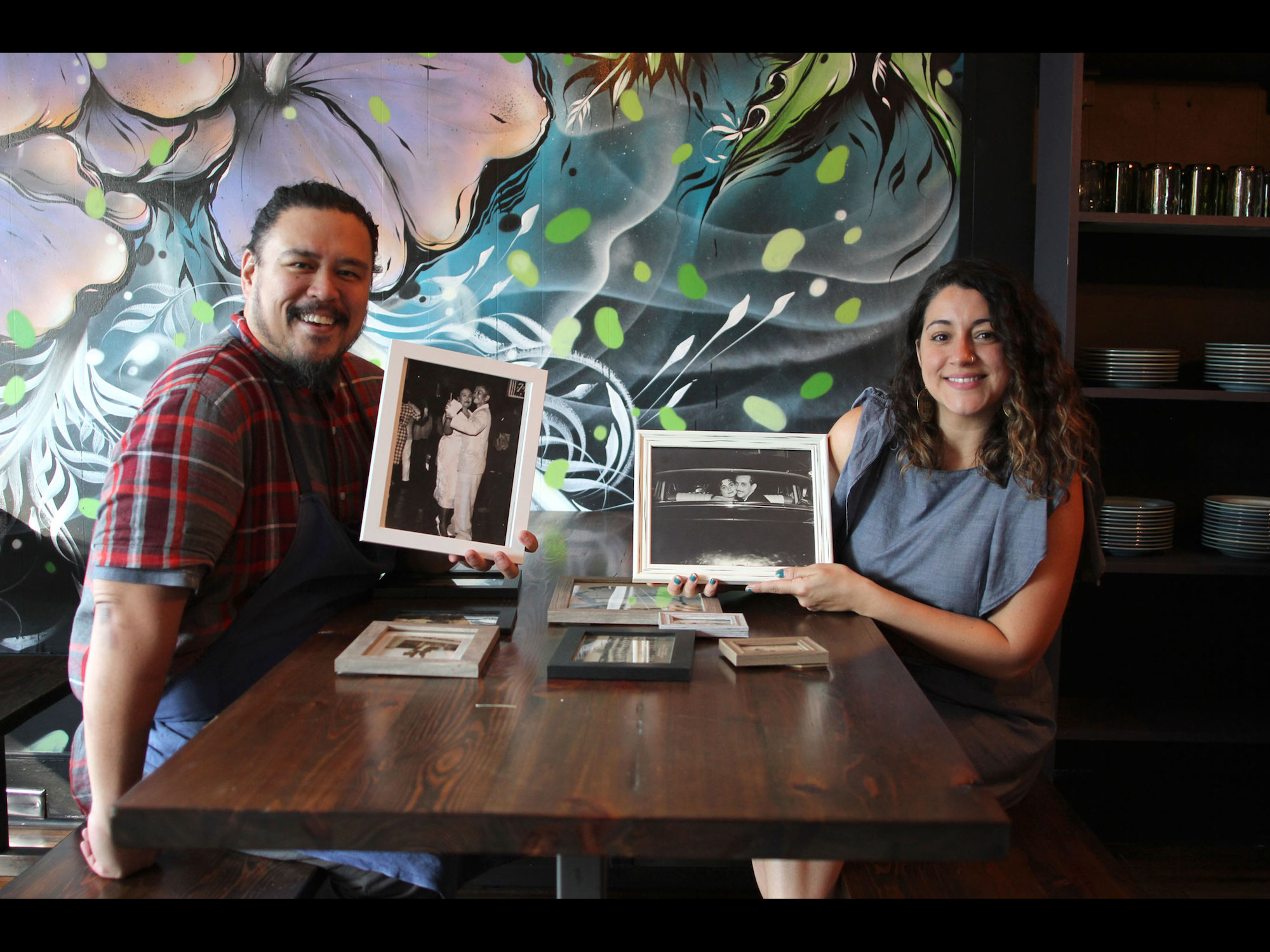IT STARTED WITH A RESTAURANT closing. Bella’Mbriana, a casual Italian restaurant in Uptown, was started by Nick Russo and his cousin Carmine from Ischia, an island off the coast of Naples. “I was the American cousin who lived here and I would go back to Italy, he was the Italian one that would come here,” Nick says of their relationship. But after two years Carmine, who was the chef, wanted to go home to stay, and so Nick found himself with a space and no chef. (And a girlfriend, Natalia, who could sing—that will become important in a moment.)
Around the same time he met Bob Monti, a lawyer who had made a mid-career switch to cooking. The space was sitting there, so last winter they decided to do an Italian brunch pop-up, really just for friends and regular customers—the location is a sort of no-man’s-land between neighborhoods (south of Andersonville, east of Ravenswood, not what you think of for Uptown), so if people found it at all, they counted as regular customers before long.
The idea came from Bob’s great-aunt in Emilia in northern Italy, who has a restaurant where “people will literally drive two or three hours to go there for lunch,” Bob says. “We did a multi-course, single price Italian Sunday lunch. People ate at communal tables, everybody ate the same thing, and people really enjoyed that. Natalia sang, put on a set.”
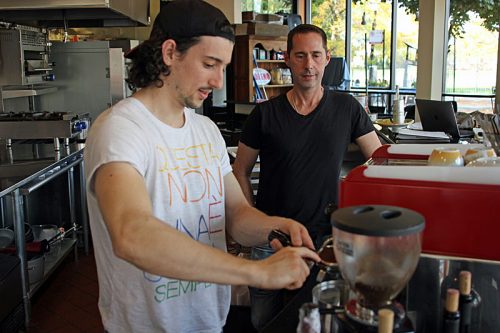
Nick Russo and Bob Monti
“What was nice was that because of the setup, everyone got to know each other,” Nick says. “They sat at the same table, and everyone experienced the same thing at the same time with the music. It was cool how new friendships were made, because of it.” To him it was exactly the sort of thing you find in their neighborhood—”There’s an Uptown vibe, a community sense of what’s going on here,” he says.
Compared to the grind of Sunday brunch at most busy brunch places in Chicago, it sounds delightfully relaxed and charming—like a Sunday afternoon in a village square in Italy. Of course, like most charming things in the city, by the time you hear about it, you’re too late for it. But the pop-ups gave Nick and Bob a chance to work together, and to develop a new restaurant for the space with something of the same feel—a neighborhood place, with a relaxed atmosphere, a simple menu, an audience of regulars coming back time and again.
The result, which opened in May, is Munno Pizzeria & Bistro, a sunny cafe, mostly windows overlooking Clark Street or the park across the way, with an open kitchen where they pull espressos and make a short list of pizzas and pastas.
They wanted to create a place where you can come for an evening and unwind over pleasant food. Where it takes a little time for your food to be made and to come to you, time enough to talk to the person you’re dining with over a glass of wine. The philosophy, as Nick expresses it, is simple and straight from that Italian cafe on the plaza: “Everybody deserves a nice meal once in a while.”
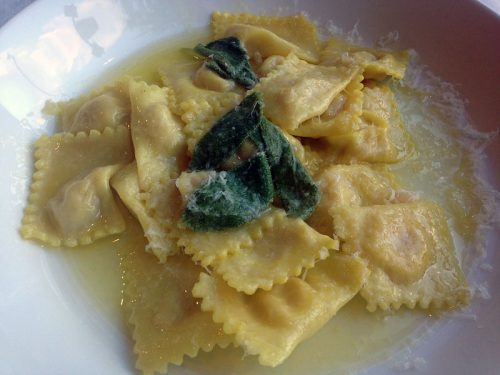
Ravioli with prosciutto, mortadella, pork, ricotta and parmesan filling in a saffron sage butter sauce
COUSIN CARMINE MAY HAVE COME from a family that owned a restaurant on Ischia for 40 years, but Nick Russo was a 21-year-old college grad with a degree in international studies and no management experience when they first teamed up. “I always had a hidden interest in food, but I never got the practice until recently,” he says.
Once he was on his own, “I had this equipment and I just started to fool around. I learned how to make gelato,” he says. Pizza seemed a promising direction, so he went to California to take a course at a Neapolitan pizza school. When he was done, he put a pizza oven in the restaurant—but it’s not a wood-burning one: “I’ve developed a way to do [Neapolitan-style pizza] in an electric oven,” which tops out at around 850 degrees. Which is high, but not quite as high as the dome inside a true wood-burning oven—though his pizza would be hard to tell apart from one at first glance, or even bite. “I’m really just trying to make a nice, light pizza that’s enjoyable.”
“Obviously I am Neapolitan, so I have that bias, but a lot of [what I like about that style] has to do with the workmanship of the pizzaiolo,” Nicks says. “They really do recognize the art of the pizza maker, just as much as they do the pizza.”
Compared to twentysomething Nick, Bob Monti is old enough to have had a long run in one career before switching to another. “I grew up in a food family, both my grandfathers were chefs,” he says. “That was back when cooking was really a trade, especially when you’re from a second generation immigrant background. I was always encouraged to learn how to cook—but not to do it professionally.”
“I wound up in law school, I’ve been practicing law for a long time, but the longer I did that, the more I was interested in food and I wanted to learn more about it,” he says. He too went off to take cooking courses—he went to a cooking school in New York while on sabbatical from his law firm in California, he spent time cooking with the great-aunt in Emilia (“She’s about 80 now and you can’t get her away from the stove”), and took a pasta-making course in Bologna.
Finally he decided to take the plunge, and moved to Chicago to look for a small restaurant space. In the course of looking he ran across the Bella’Mbriana space and met Nick. From there they did the pop-up brunch, and then started thinking about what could work in the small kitchen space, with its limited equipment—the pizza oven, a range, and a salamander.
“What you see is what you get,” Nick says. “It allows us to do what we’re doing.”
“That drives the simplicity of the menu, what can we do well given the constraints we have,” Bob says. “We’re not really identified with any one specific region of Italy, but the concept is to do cooking inspired by regional Italian cooking. The pizza comes from the Neapolitan tradition, but the pastas come more from Emilia-Romagna, using a rolling pin to roll it out, that old Italian tradition that even people in Italy aren’t doing that much any more.”
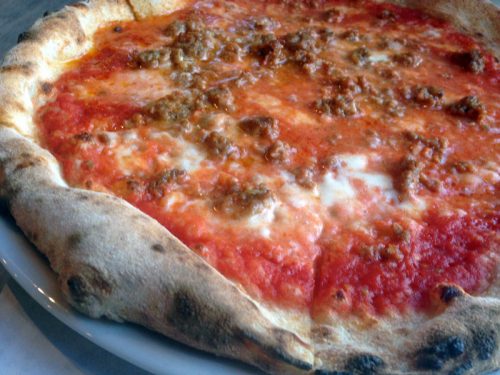
Salsiccia pizza with pork sausage, fresh mozzarella, Sardinian feta, Calabrian chiles
One thing I hadn’t thought about when I sat down to talk with them in the cafe is that the idea of a cafe or a bar comes with different assumptions for Italians. “One of the difficulties with operating as a bar here is that in Italy, being a bar can mean that you serve small plates,” Nick says. “It’s a lot more food-centric than a bar is for Americans. Little places, even just coffee bars, can be much more food-focused.”
“And not just serving a danish from the same bakery where everyone else gets them,” Bob says.
“That’s where the bistro comes in, too, because as you can see, we’re right here,” Nick says, pointing to the tiny kitchen area behind the bar. “There aren’t any secrets about what we’re doing here. The word ‘bistro,’ I think makes it a little more friendly—the word ‘pizza’ invites you in, too, a little more.”
I grew up in a food family, both my grandfathers were chefs. I was always encouraged to learn how to cook—but not to do it professionally.
“In Italy, they say, you go to a pizzeria for a pizza—and nothing else,” Bob says. “And you don’t go to a trattoria for pizza. So in a way we’re bucking that trend a little bit, and trying to deliver nice quality on both fronts. It’s about that Italian experience of coming to a humble restaurant, but being impressed by the quality of the food.”
The short menu is a function of not just the small kitchen but the fact that it’s just the two of them making everything. “We make the ravioli together, just the two of us, we can make from 500 to 1000 raviolis in a couple of hours,” says Nick. “He makes most of the pastas, but I make the gelato and the eggplant parmagiana. This is definitely a very hands-on cuisine, and that’s why we chose Neapolitan pizza specifically, but this style of cooking generally. My family’s very hand-oriented, and that’s why it fits for me.”
The recipes are true to the spirit of Italian food in Italy, but tweaked a little for American tastes—or just their own. The ravioli are based on classic tortellini in brodo, tortellini in broth, and they originally made it for one of the brunches. But they went to larger ravioli to make production easier, and added some ricotta to the filling to lighten it up, so it wasn’t just a big meatball. It’s served with an equally classic sage and butter sauce. “That’s basically it, trying to take inspiration but interpreting it a little bit,” Bob says.

Lasagna alla Bolognese with spinach pasta, traditional ragu, béchamel and parmesan
“And packing it with flavor. There’s a lot packed in those little ravioli,” Nick says. “Flavorful, but light, that’s what we’re aiming for.”
It’s the same on the pizza side. “It’s a long process—you’re eating something that I started thirty hours ago,” Nick says. At the same time, it’s about simplicity—”There’s a reason why Neapolitan ingredients are so simple, even as far as the quantity you put on, because it affects the cooking in the oven—the more sauce or the more ingredients, the longer it’s going to take to cook.” Instead they look for ingredients that, again, pack a lot of punch in small volume, like the housemade sausage with its touch of heat, and offer just five pizzas, perhaps with a special.
“I think the original idea in my head at least was, since we have such a small menu, change it seasonally or frequently, rotate in some specials,” Bob says. “But it’s funny, people have their favorites.” Regulars with favorites, after just five months. That’s what any restaurateur would call success, no?
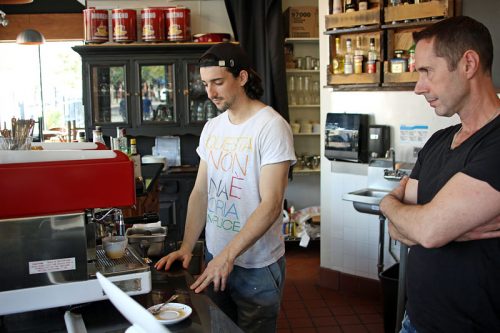
IT WOULDN’T BE AN ITALIAN CAFE without wine, and though again, the list is short, it’s well-focused—and strictly Italian. “We tried to carry that simplicity throughout with wines, as well. Making it accessible, having some varieties that people aren’t so familiar with. Because it’s a small list, there’s a little momentum toward trying something new,” Bob says. It’s ironic, then that Bob notes that Italians generally don’t drink wine with pizza—they drink beer. (Also an all-Italian list.) “If you’re having a nice, limited, well-curated menu, you want to take a consistent approach with wine and beer, too.”
A sense of their limits is why they’re only open four nights a week right now, Thursday through Sunday—though they plan to expand soon to weekend lunch, which seems to fit the neighborhood’s habits. Sticking with what’s achievable in their space is also why they have a policy that has caused some consternation in their Yelp reviews: they don’t do to-go orders. The reason is simple: they’d find themselves cranking out pizzas all night for GrubHub and DoorDash delivery, to the detriment of the experience being enjoyed by the diners in the restaurant.
“Our target audience is someone who wants to spend time here,” says Nick. “They see the limited amount of people working here and they tend to just relax about it. And then, they get to know the waitstaff,” who include the aforementioned Natalia as well as a couple of others. “And they get to know us, because it’s just us.”
“We had a waiter over the summer who was an Italian kid going to school at Purdue. And the regulars were notably sad to see him go,” Bob adds.
Talking about the best restaurants of the year tends to point you toward big, splashy places with big, ambitious menus—the Pacific Standard Times and Tao Chicagos of 2018. But the focused modesty of a place like Munno is a virtue, too—maybe even what we come to treasure more, when we discover it.
“We’re very humble, as I hope you can kind of see,” Nick says. “We’re not trying to be better than anyone else, I don’t think we really have chef egos per se.”
“It’s not about the chefs, it’s about the food we put out,” Bob agrees. “I think the goal for us is longevity—we’d rather have a sustainable business that people enjoy coming to for a long time, than to be the foodie flash in the pan where you’re hot for a little bit. To have a business where you’re enjoying it, and earning a living, and making a lot of people happy with your food—”
“And becoming actual friends,” Nick says, chuckling almost in disbelief, “with these people who have been giving us business, who invite us to their homes.” That’s the kind of thing you might be kind of skeptical about, about it really happening in America. But it’s just what you’d expect from the Italian cafe on the village square.

Michael Gebert makes a mean lasagna himself as editor at Fooditor.
Latest
Join the Discussion
After you comment, click Post. If you're not already logged in you will be asked to log in or register with Disqus.





